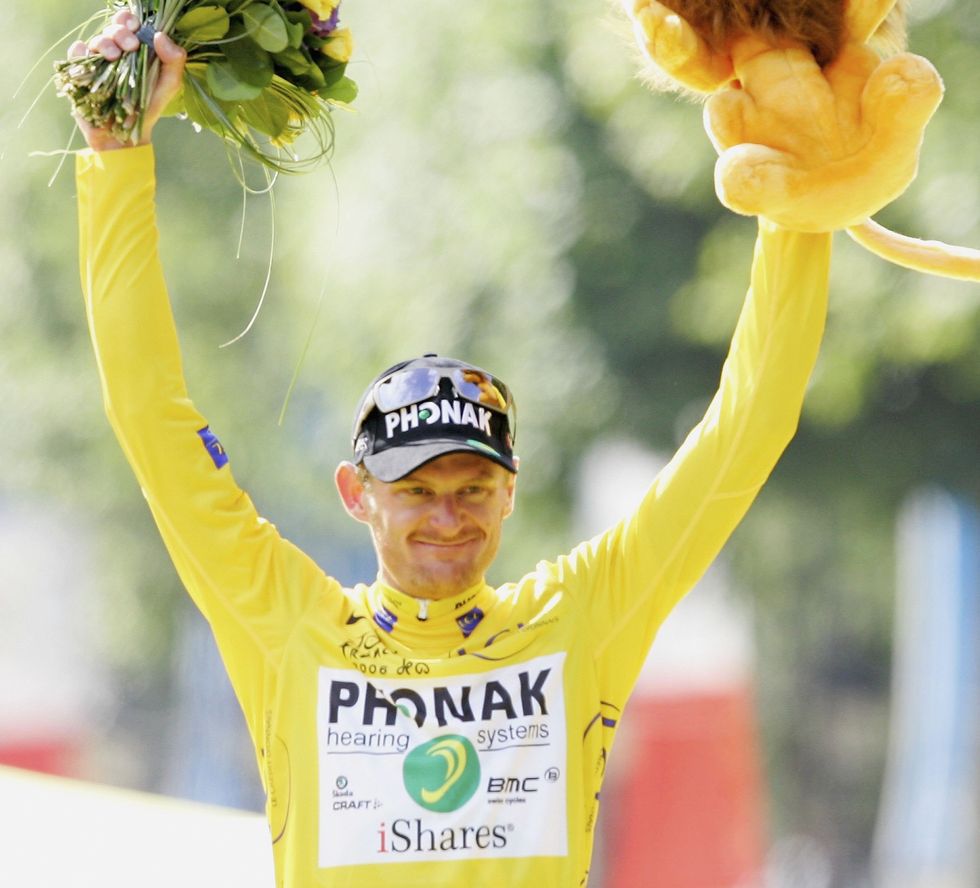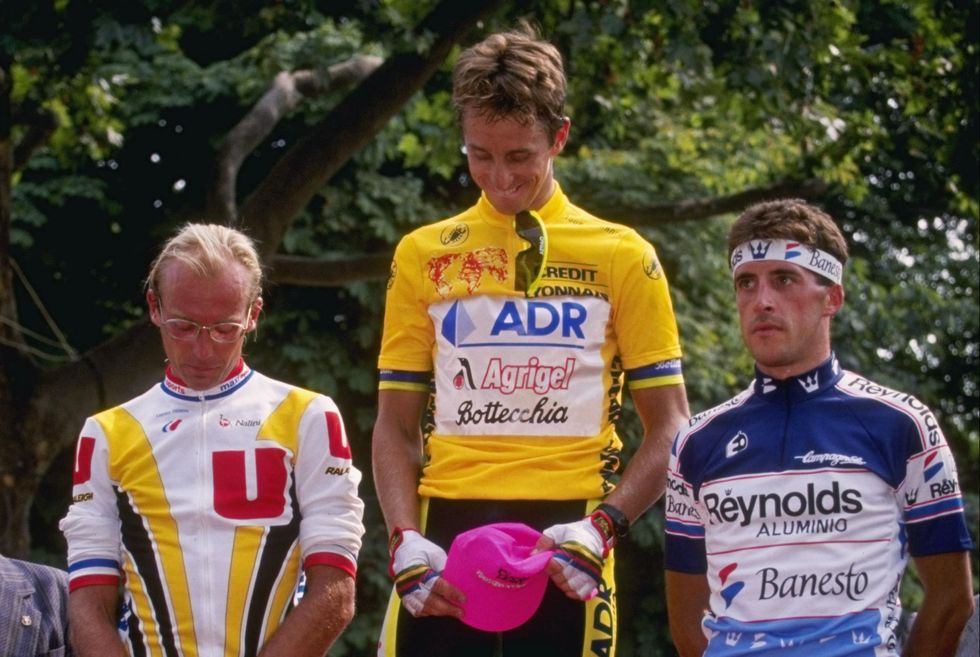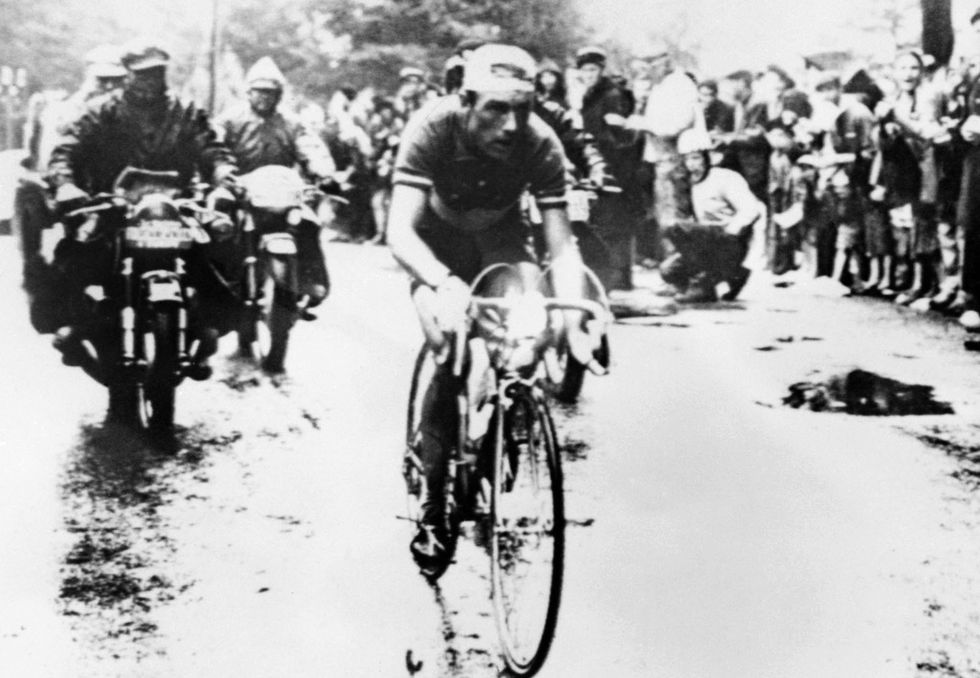2006—Floyd Landis

Friedemann Vogel//Getty Images
A year after Lance Armstrong’s retirement, it looked like the trend of American winners might continue when Floyd Landis took the yellow jersey on Stage 11. But just two stages later, the longest stage of the Tour on a boiling hot day in southern France, Landis lost the lead in stunning fashion to what the Italians call a fuga bidone: a long, innocent-looking break that contains a high-quality rider.
Landis would regain the lead on Stage 15 on the Alpe d’Huez finish, but the next day, Landis suffered a shocking 10-minute crack on the summit finish to la Toussuire and dropped out of the top 10.
What happened on Stage 17 should’ve been the stuff of legend: Landis set his team on the front on the first big climb, more than 100 kilometers from the finish. With the group whittled down, he launched a solo attack, catching up to and eventually dropping the early breakaway and powering over four summits to the finish in Morzine almost six minutes ahead of the chase. The raid vaulted him back to third overall, just 30 seconds behind Oscar Pereiro, the leader at the time. Landis regained yellow only on the penultimate time trial despite a valiant defense by Pereiro, and rode triumphantly to Paris with one of the slimmest leads in race history—57 seconds.
Then, days later, disaster: a positive test for testosterone. Landis denied and fought the charge, but ultimately lost his title and was banned for two years; Pereiro was declared the winner. The sport essentially shunned Landis even after his ban elapsed, which set in motion the fateful turn of events years later that would result in Armstrong’s own downfall and life ban for doping.
1989—Greg LeMond

Getty Images//Getty Images
No final Tour stage has ever shocked the racing world like the 1989 Tour, when Greg LeMond clawed 58 seconds out of yellow jersey holder Laurent Fignon in just 24.5 kilometers with a stunning time trial ride.
But the final-day fireworks doesn’t tell you that the ’89 Tour was a see-saw battle for the entire race. Fignon won the Tour in 1983 and ’84 but battled tendon issues in his knee and ankle in the following years. In 1989, he was finally back in top shape, having won May’s Giro d’Italia (LeMond finished 39th).
The two traded yellow back and forth no fewer than five times during the Tour, separated by just a handful of seconds for much of the race. Riding for the underpowered ADR team, LeMond capitalized on time trials, where team strength and tactics aren’t a factor, and seized yellow with a Stage 5 time trial win. He lost it shortly after to Fignon in the Pyrenees. Another strong time trial performance in Stage 15 reclaimed the lead for LeMond, but Fignon deployed his powerful Super-U team to take it back on Stage 17’s Alpe d’Huez finish. He added 24 more seconds the next day, which many thought would be a comfortable enough margin to ensure the Frenchman’s third Tour win ahead of the short, slightly downhill final stage.
LeMond had experimented with aero gear in the previous time trials, using a teardrop-shaped Giro helmet and the now-iconic clip-on handlebars in the 73-kilometer Stage 5 time trial. He donned that gear in the final stage, while Fignon opted to ride without either, choosing a conventional time trial bike with only cowhorn bars, and going bareheaded (helmets weren’t mandatory in racing until 2003).
Much like Primož Roglič in the final TT of the 2020 Tour, Fignon was losing time to LeMond from the start. LeMond opted not to get time splits from his director, but Fignon did. Entering the Champs-Elysées, he had a tiny lead of just two seconds, but LeMond’s average speed of 54.55 kph—still one of the fastest TTs in Tour history—was simply too much to match, and Fignon conceded 10 seconds in the final kilometers, losing the Tour by just eight seconds—the closest margin in the race’s 107 editions.
1958—Charly Gaul

STAFF//Getty Images
No fewer than eight riders wore yellow in this epic race, and the jersey changed hands 10 times. The race was animated by the greats of cycling’s so-called golden age, like sprinter Andre Darrigade, who won five stages (and 22 total in his career); the Spaniard Federico Bahamontes, one of the best climbers—and worst descenders—the sport has ever seen; Raphael Geminiani, the Italian answer to Raymond “Mr. Second Place” Poulidor and the inspiration for the Rapha brand name; and the enigmatic Charly Gaul, a fantastically gifted time trial rider and climber who had almost won the Giro d’Italia that year.
Despite his ferocious talent, Gaul didn’t even crack the top 10 overall until Stage 14. After 17 stages (that year’s Tour had 24 total) he was still almost 11 minutes down to leader Vito Favero. A convincing time trial win on Mont Ventoux began to cut into the margin, but he lost time again on Stage 20 and was just sixth overall, 16:03 down to Geminiani, and with major talents like Jacques Anquetil between him and the lead.
Then, on Stage 21, the last day in the Alps, racers awoke to a cold rain—a gift for Gaul, who delighted in bad weather. The stage was punishing: 219 kilometers with five major climbs. Gaul attacked out of the main group on the descent off the first climb, the Col du Lauteret, and rode through the remnants of the early break. On the second climb, Gaul dropped Bahamontes in a driving rain and forged on alone. At the finish, he was almost eight minutes ahead of the next rider; Gaul was now third, just 1:07 behind Favero.
Stage 23 was perfect for Gaul: an arduous 73-kilometer time trial, and he left little to suspense, winning his fourth stage and putting three minutes into Favero and Geminiani, a margin he easily held to the finish the next day in Paris.
Advertisement – Continue Reading Below
1937—Roger Lapébie

STAFF//Getty Images
Between 1930 and 1961, the Tour was contested by national teams, not trade teams. Italian Gino Bartali, one of the great campionissimos of Italian cycling, was in firm control of the 1937 Tour when he crashed on Stage 9 and lost 22 minutes, ceding the yellow jersey to defending champion Sylvère Maes. Bartali was forced to drop out three days later.
With his chief rival out of the race, Maes and the powerhouse Belgian team looked like a lock for the win. They won three straight stages including a team time trial on Stage 11B to solidify Maes’s lead over Frenchman Roger Lapébie.
Then things began to fall apart. The partisan French organizers, looking to blunt the strength of the Belgian team, changed the format of several stages from team time trials to mass-starts. In the Pyrenees, French fans pushed Lapébie up the climbs. (Although 1937 was the first year the Tour allowed derailleurs, the devices were still pretty crude and many riders had to walk steeper sections of climbs, which were often unpaved.) Decades later, Tour official and eventual race director Felix Lévitan would confess that even he had given Lapébie a helping hand.
But the dam broke on Stage 16. Maes flatted and was penalized after teammates waited to help him chase. Lapébie went through a railroad crossing just before an approaching train, while Maes, chasing close behind, did not make it in time to cross before the train.
Furious, Maes and the entire Belgian team quit the race. Without the Belgians, Lapébie’s only real competition was the Bartali-less Italian team, and it was no contest. He would win two stages over the reduced field in the final days and carry yellow to Paris with the third-smallest margin (7:17) of the pre-WWII Tours.
>>> Read full article>>>
Copyright for syndicated content belongs to the linked Source : Men’s Health – https://www.menshealth.com/entertainment/g46244335/tour-de-france-biggest-comebacks/






























